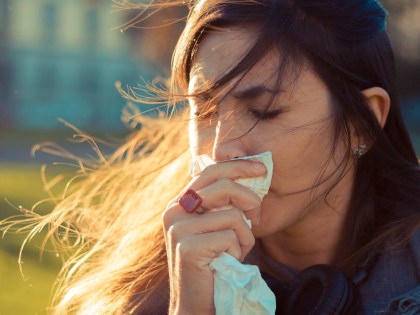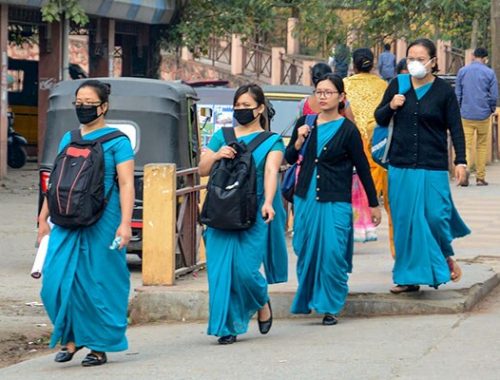Survey data collected by Facebook is being used to power new COVID-19 “symptom maps” that could soon to predict how the infectious disease is spreading across the U.S.
An interactive dashboard, which is being updated daily, shows a full county-by-county breakdown of the percentage of people who reported having symptoms, not confirmed cases. The results are based on data from a project being run alongside researchers from Carnegie Mellon University.
Facebook CEO Mark Zuckerberg said today that such analysis could help governments and healthcare experts better allocate resources and conduct economic planning, such as when to reopen local regions or where to distribute ventilators and protective medical gear.
“Researchers believe these symptom survey maps can be an important tool in making these decisions,” the billionaire entrepreneur, 35, wrote on his personal account.
Carnegie Mellon’s Delphi Research Center said in a blog post today that its survey, promoted on the social network, is generating about one million responses per week from users. Representatives from both teams stressed individual survey responses are not directly shared with Facebook.
The university’s own suite of maps also includes anonymized data sent by other organizations, including Google, Quidel Corp. and an unnamed national health care provider, the team said.
Facebook said the Carnegie Mellon survey asks users to voluntarily share if they—or anyone in their home—have suffered from symptoms associated with COVID-19 or the flu within the past 24 hours. Every day a new sample of users over the age of 18 are invited to answer the questions.
“The survey asked people if they have symptoms such as fevers, coughing, shortness of breath or loss of smell that are associated with COVID-19,” Zuckerberg wrote in The Washington Post.
“Since experiencing symptoms is a precursor to becoming more seriously ill, this survey can help forecast how many cases hospitals will see in the days ahead and provide an early indicator of where the outbreak is growing and where the curve is being successfully flattened.”
The social networking giant said it will expand the research project by running the surveys globally from this week, repeatedly noting that it will not see users’ direct responses.
“This will allow us to expand the symptom maps to provide county-by-county data across almost every country in the world where Facebook operates,” Zuckerberg wrote.
“We’re looking for more… partners around the world to help generate insights from this aggregate data to help the COVID-19 response. We’ll share more details on how to get involved soon.”
The Carnegie Mellon team said the survey data will be used to forecast COVID-19 activity “several weeks” into the future – added that it could fill crucial gaps in county data.
It said: “Within…weeks, [researchers] expect to use these estimates to provide forecasts that will help hospitals, first responders and other health officials anticipate the number of COVID-19 hospitalizations and ICU admits likely to occur in their locales several weeks in advance.”
Facebook has been contacted for comment.
There have now been more than 759,000 COVID-19 infections in the U.S., according to a map being maintained by Johns Hopkins University. The disease has claimed the lives of at least 40,683 U.S. citizens. Globally, there have been more than 2.4 million infections and at least 166,205 deaths.
Centers for Disease Control and Prevention Advice on Using Face Coverings to Slow Spread of COVID-19
• CDC recommends wearing a cloth face covering in public where social distancing measures are difficult to maintain.
• A simple cloth face covering can help slow the spread of the virus by those infected and by those who do not exhibit symptoms.
• Cloth face coverings can be fashioned from household items. Guides are offered by the CDC. (https://www.cdc.gov/coronavirus/2019-ncov/prevent-getting-sick/diy-cloth-face-coverings.html)
• Cloth face coverings should be washed regularly. A washing machine will suffice.
• Practice safe removal of face coverings by not touching eyes, nose, and mouth, and wash hands immediately after removing the covering.
World Health Organization advice for avoiding spread of coronavirus disease (COVID-19)
Hygiene advice
• Clean hands frequently with soap and water, or alcohol-based hand rub.
• Wash hands after coughing or sneezing; when caring for the sick; before, during and after food preparation; before eating; after using the toilet; when hands are visibly dirty; and after handling animals or waste.
• Maintain at least 1 meter (3 feet) distance from anyone who is coughing or sneezing.
• Avoid touching your hands, nose and mouth. Do not spit in public.
• Cover your mouth and nose with a tissue or bent elbow when coughing or sneezing. Discard the tissue immediately and clean your hands.
Medical advice
• Avoid close contact with others if you have any symptoms.
• Stay at home if you feel unwell, even with mild symptoms such as headache and runny nose, to avoid potential spread of the disease to medical facilities and other people.
• If you develop serious symptoms (fever, cough, difficulty breathing) seek medical care early and contact local health authorities in advance.
• Note any recent contact with others and travel details to provide to authorities who can trace and prevent spread of the disease.
• Stay up to date on COVID-19 developments issued by health authorities and follow their guidance.
Mask and glove usage
• Healthy individuals only need to wear a mask if taking care of a sick person.
• Wear a mask if you are coughing or sneezing.
• Masks are effective when used in combination with frequent hand cleaning.
• Do not touch the mask while wearing it. Clean hands if you touch the mask.
• Learn how to properly put on, remove and dispose of masks. Clean hands after disposing of the mask.
• Do not reuse single-use masks.
• Regularly washing bare hands is more effective against catching COVID-19 than wearing rubber gloves.
• The COVID-19 virus can still be picked up on rubber gloves and transmitted by touching your face.
Health




